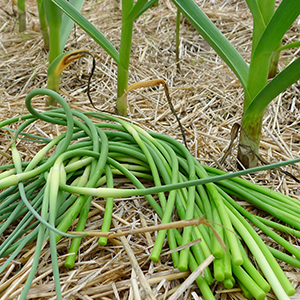
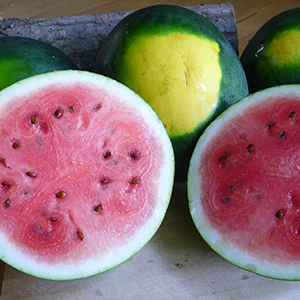
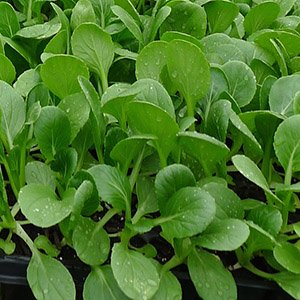

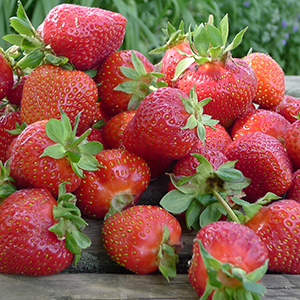
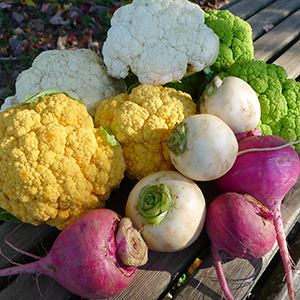
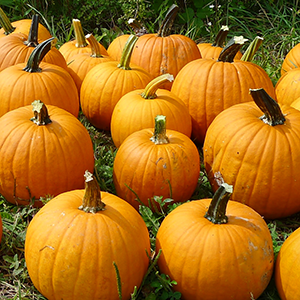



News and Notes | The Anchor Run Blog
Posts Filtered by Month - September 2018 |
Show Recent Posts
September 30, 2018
Fall Veggies Please Stand Up
by Farmer Dana
Fall Veggies Please Stand Up
by Farmer Dana
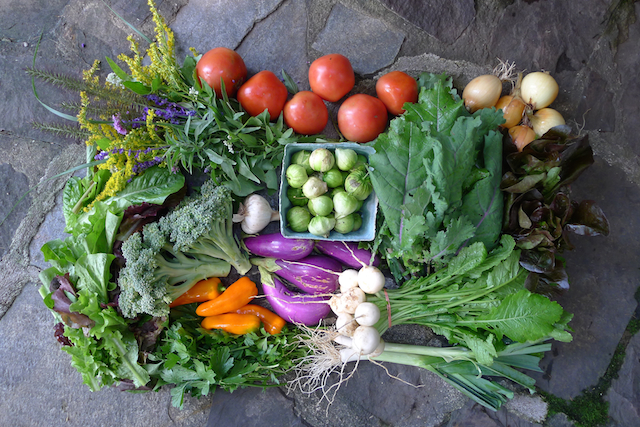
Harvest #20 (Week B) should include beets with greens, turnips with greens, herbs (parsley, dill, cilantro), sweet peppers, eggplant, hot peppers, tomatoes, potatoes, leeks, onions, garlic, lettuce, cabbage, broccoli, and greens (kale, escarole, Italian dandelion, bok choy, etc.). Some items will be a choice and might not be available at all times. U-pick should include tomatillos, flowers, and herbs.

September 30, 2018
Workshifts this Week (10/1-10/7)
by Farmer Derek
Workshifts this Week (10/1-10/7)
by Farmer Derek
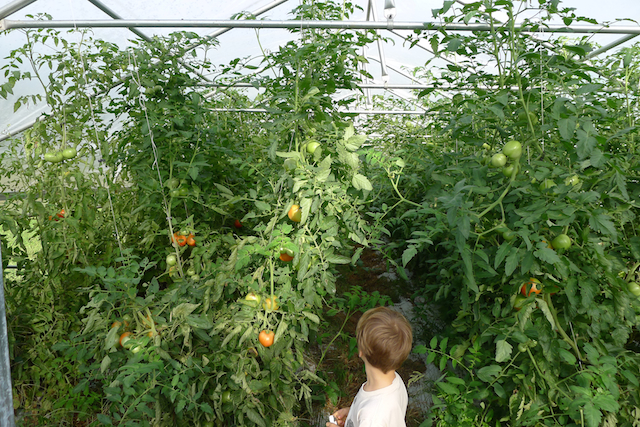
Tomatoes inside our hoop tunnel are still producing but will soon need to make way for fall and winter crops.
Workshifts scheduled for this week:
- Tuesday (10/2) 10:00am-12:00noon
- Wednesday (10/3) 10:00am-12:00noon
- Wednesday (10/3) 5-7pm
- Friday (10/5) 10:00am-12:00noon
- Sunday (10/7) 9-11am
Workshift sign-up instructions may be found here.
We're quickly approaching the end of farm work opportunities so please consider signing up soon for a workshift if you chose the work discount option for your share. If you chose the discount but don't think you'll be able to fulfill the work obligation simply send us a check to cover the hours/balance (4 hours for a half share, $60; 6 hours for a medium share, $90; 8 hours for a full share, $120; or $15/hour if you worked partial).
Thank you!

September 30, 2018
Final Potluck of the Season - 10/6/18
by Farmer Dana
Final Potluck of the Season - 10/6/18
by Farmer Dana
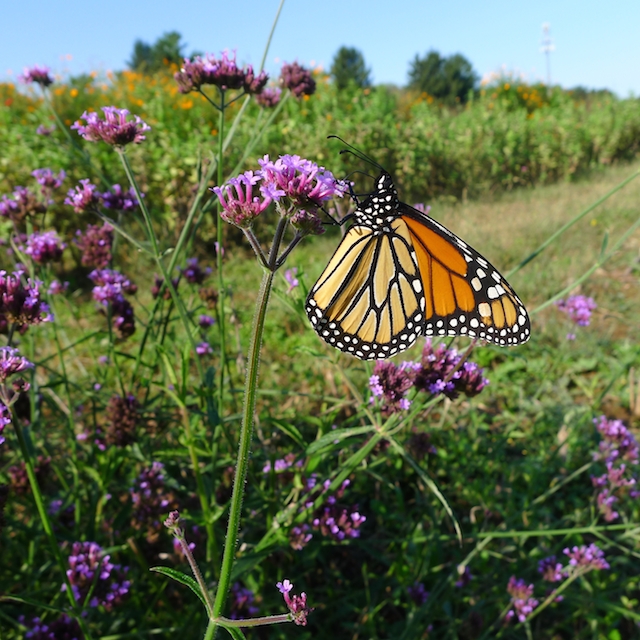
Thank you monarch for gracing us with your presence!
Help us celebrate the conclusion of our 10th season at Anchor Run Farm by joining us for a shared meal under the pavilion 4:30-9pm. Bring a dish to share that serves 4-6 adults, your own place settings, and a beverage of your choice. We'll have a small fire after the meal. Musical instruments and voices for singing are very much welcomed.

September 30, 2018
The Return of the Sun King
By Derek McGeehan
The Return of the Sun King
By Derek McGeehan
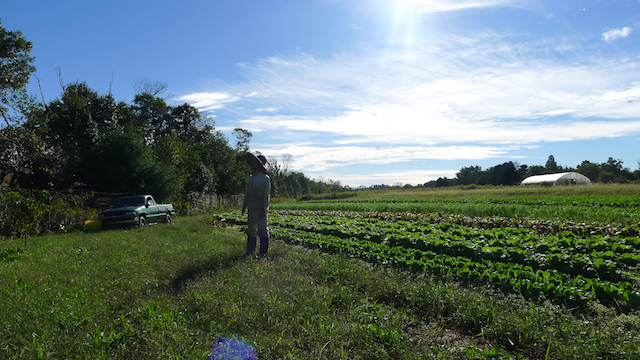
The first sunny harvest morning in weeks was a welcome relief but also a reminder of the hustle needed when harvesting lettuces, herbs, and greens.
We're welcoming October with open arms and smiling faces (and sunglasses) as a forecast of crisp cool sunshine beautiful weather descends and hopefully stays in place for weeks and weeks. September was a rough month for sure and we're happy to turn this page of the calendar. With the new month we're anticipating the harvest of some traditional early fall crops like broccoli, cabbage, and hakurei turnips. We're thankful to harvest any broccoli and cabbage at all and overall I'm sure the quantity and quality won't match the past few seasons but at least there should be some to whet our brassica appetite. In their footsteps over the next month should be cauliflower, watermelon radishes, and daikons.
Now that the ground is drying out and the sun is shining once again we can resume our normal weed control schedule and pull out all those freeloaders out there that thought they could grow unchallenged while they attempt to out-compete their more sensitive brethren, the crops we want to eat. We're thinking this week will be a turning point in the season when we can begin to feel a positive connection with the fields once again. We're looking forward to harvesting sweet potatoes and being pleasantly surprised by a good yield. We're predicting a renaissance of greens in the coming weeks as they soak up the sun and are able to consume the soil's nutrients without drowning. Spinach will grace us in two weeks time with an abundance of healthy dark green leaves. The first frost won't occur until November and the first freeze not until December. The first deep freeze won't happen until January. In the meantime we'll have an awesome fall season with bountiful harvests. Cheers!

September 30, 2018
Late Fall, Winter, and 2019 Main Season
by Farmer Dana
Late Fall, Winter, and 2019 Main Season
by Farmer Dana
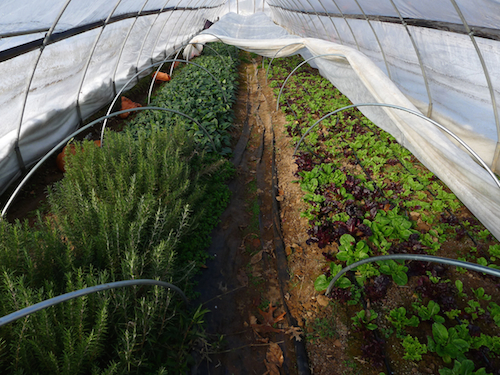
Rosemary, spinach, and lettuce mix, January 11th, 2018 in the hoop house. That's snow piled up outside along the sides. Inside, crops are thriving.
Announcing open registration for Anchor Run's 2018 Late Fall CSA, 2018-2019 Winter CSA, and 2019 Main Season CSA!
Members can now sign up for three separate seasons through the members page on our website.
Scroll down for additional information for each season. E-mail us (anchorruncsa@gmail.com) if you have any questions.
2018 Late Fall CSA
- Full, Medium, and Half Shares are available for the 7th annual 6-week season.
- Prices remain the same as last season: $180 for Full; $130 for Medium; $100 for Half.
- A deposit of $50 or full payment secures your share; full payment is due by November 15th.
- A cold hardy fall themed continuation of the Main Season share with tasty staples like lettuce, spinach, radicchio, arugula, mizuna, tatsoi, bok choy, kale, collards, chard, cabbage, Napa cabbage, cilantro, dill, parsley, leeks, garlic, onions, beets, radishes, turnips, carrots, celeriac, kohlrabi, rutabaga, potatoes, and sweet potatoes. No u-pick crops.
- A Full Share receives approximately 8-12 pounds of produce weekly, a Half Share every other week, and a Medium Share receives 2/3 of a Full Share weekly.
- To join, log in to the website here; the 'join' button will be on the left hand side of your members page.
- Total membership is approximately 50% of the Main Season and is filled on a first come first served basis so don't delay!
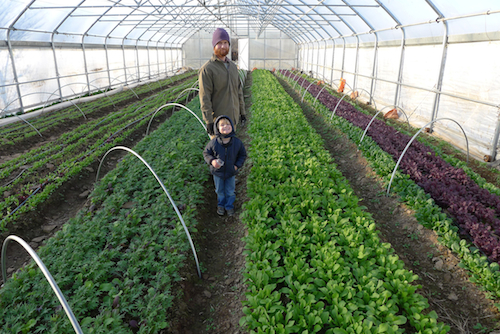
Farmer Derek and farm intern Gabe inside the movable high tunnel in mid-December 2017. Fall and winter greens are looking good!
- Pick up days are: Wednesday 1-8pm or Saturday 11am-12noon (you choose a day but you can switch temporarily by notifying us in advance).
- Begins immediately following conclusion of 2018 Main Season CSA Harvest Week #26.
- Late Fall Harvest #1 (Week A) is scheduled for week of November 19th*.
- *During the week of Thanksgiving, Late Fall Harvest Week #1 (Week A), Wednesday's pick up is on Tuesday, November 20th to accommodate the many travelers and holiday schedules.
- Concludes week of December 24th**.
- **During the week of Christmas, Late Fall Harvest Week #6 (Week B), Wednesday's pick up is on Thursday, December 27th, due to holiday traveling.
- No workshift discount/commitment.
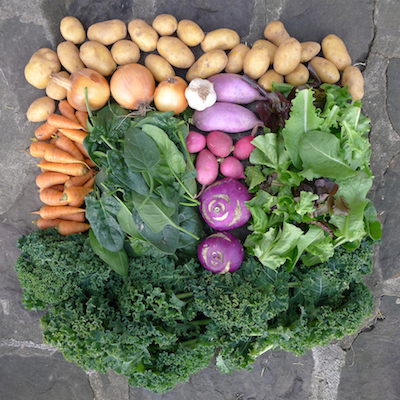
Late Fall CSA share #6, December 18th, 2017.
2018-2019 Winter CSA
- Full, Medium, and Half Shares are available for the 4th annual 6-week season (shorter season than last year due to farmers needing a break before 2019 Main Season work commences at the end of February. Also a need for an off-farm vacation.).
- Prices are the same as Late Fall: $180 for Full; $130 for Medium; $100 for Half.
- A deposit of $50 or full payment secures your share; full payment is due by December 31st.
- A cold hardy winter themed continuation of the Late Fall share with tasty staples like lettuce, spinach, radicchio, arugula, mizuna, tatsoi, bok choy, kale, collards, chard, cabbage, Napa cabbage, cilantro, dill, parsley, leeks, garlic, onions, beets, radishes, turnips, carrots, celeriac, kohlrabi, rutabaga, potatoes, and sweet potatoes. No u-pick crops.
- A Full Share receives approximately 8-12 pounds of produce weekly, a Half Share every other week, and a Medium Share receives 2/3 of a Full Share weekly.
- To join, log in to the website here; the 'join' button will be on the left hand side of your members page.
- Total membership is approximately 30% of the Main Season and is filled on a first come first served basis so don't delay!
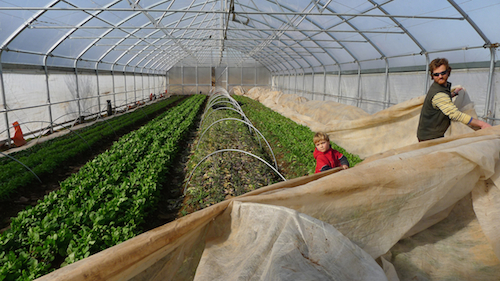
Uncovering movable high tunnel greens in late January during a winter warm spell. Uncovering and recovering happens quite frequently during the cold months.
- Pick up days are: Wednesday 1-8pm or Saturday 11am-12noon (you choose a day but you can switch temporarily by notifying us in advance).
- Begins immediately following conclusion of Late Fall CSA Harvest Week #6.
- Winter Harvest #1 (Week A) is scheduled for week of December 31st.
- Concludes week of February 4th.
- No workshift discount/commitment.
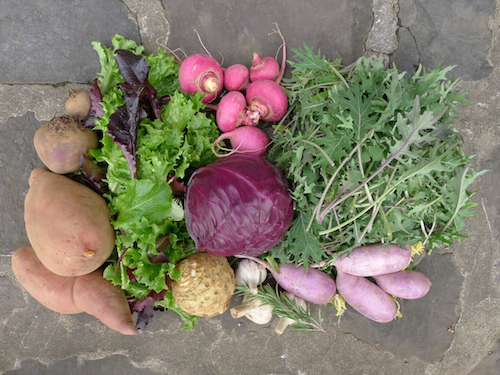
Winter CSA share #5 in late January 2018.
2019 Main Season CSA
- Full, Medium, and Half Shares are available for the 16th annual 26-week season.
- Prices remain the same as last season: $920/$800 for Full; $675/$585 for Medium; $490/430 for Half.
- A deposit of $200 or full payment secures your share; full payment is due by May 1st.
- Pick up days are the same as always: Monday 1-8pm, Thursday 1-8pm, or Saturday 10am-12noon (you choose a day but you can switch temporarily by notifying us in advance).
- Typically begins in mid-May and ends in mid-November.
- Work discount options are available for each share size. 8 hours for Full, 6 for Medium, and 4 for Half.

September 23, 2018
Workshifts this Week (9/24-9/30)
by Farmer Dana
Workshifts this Week (9/24-9/30)
by Farmer Dana
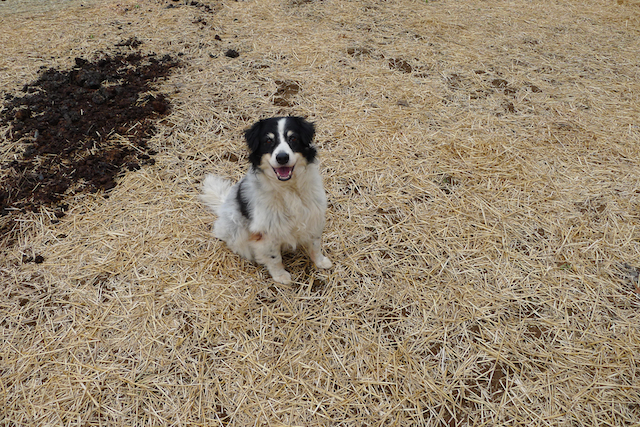
At least farm dog Borchie is smiling despite the weather.
Workshifts scheduled for this week:
- Wednesday (9/26) 10:00am-12:00noon
- Friday (9/28) 10:00am-12:00noon
- Sunday (9/30) 9-11am
Workshift sign-up instructions may be found here.
We're quickly approaching the end of farm work opportunities so please consider signing up soon for a workshift if you chose the work discount option for your share. If you chose the discount but don't think you'll be able to fulfill the work obligation simply send us a check to cover the hours/balance (4 hours for a half share, $60; 6 hours for a medium share, $90; 8 hours for a full share, $120; or $15/hour if you worked partial).
Thank you!

September 23, 2018
Final Potluck of the Season - 10/6/18
by Farmer Dana
Final Potluck of the Season - 10/6/18
by Farmer Dana

Will this swallowtail butterfly caterpillar larva be at the potluck?
Help us celebrate the conclusion of our 10th season at Anchor Run Farm by joining us for a shared meal under the pavilion. Bring a dish to share that serves 4-6 adults, your own place settings, and a beverage of your choice. We'll have a small fire after the meal. Musical instruments and voices for singing are very much welcomed.

September 23, 2018
What's Good
by Farmer Derek
What's Good
by Farmer Derek
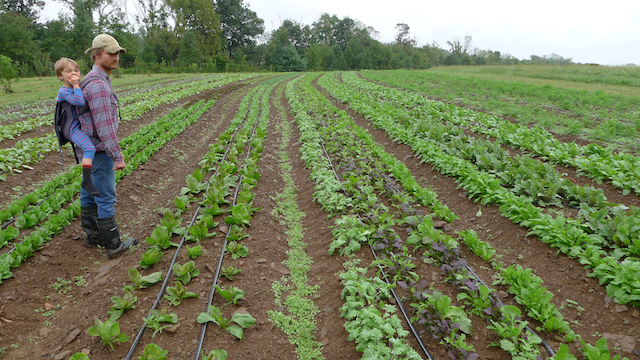
Assessing fall crops in Field 7c a week or so ago. Carrots, watermelon radishes, daikon radishes, rutabaga, hakurei turnips, arugula, greens mix, kale, radicchio, lettuce, dill, cilantro, parsley, fennel, spinach, chard, napa cabbage, kohlrabi, and bok choy. It's a cosmopolitan field.
Harvest #19 (Week A) should include beets with greens, potatoes, leeks, onions, garlic, tomatoes, lettuce, greens (kale, dandelion, endive), herbs (dill, cilantro, parsley), sweet peppers, hot peppers, okra, eggplant, carrots, and celeriac. Some items will be a choice and some may not be available during all pick up times. U-pick should include husk cherries, tomatillos, herbs, and flowers.
*<>*We're doing our best to ensure a steady flow of produce from the fields to the pick up room. Suffice it to say it has been a very challenging growing season, mostly due to excessive rain (probably will end up being our wettest season in 10 years). Up until now we've felt fairly pleased with the overall yield and harvest of most of the crops considering the adverse weather but right now we are noticing slow and stunted growth of some of our early fall staples that typically begin yielding extremely well by now such as savoy cabbage, broccoli, kale, chard, spinach, arugula, and greens mix. There has been an obvious slow down in growth the past few weeks due to an absent sun and too much moisture. We hope from your perspective that the pick up room produce has been satisfactory and that you understand the connection between weather and farming. We do apologize for this inconvenience and will think critically for ways to avoid this problem in the future.*<>*

September 23, 2018
Just Another Challenge
by Farmer Derek
Just Another Challenge
by Farmer Derek
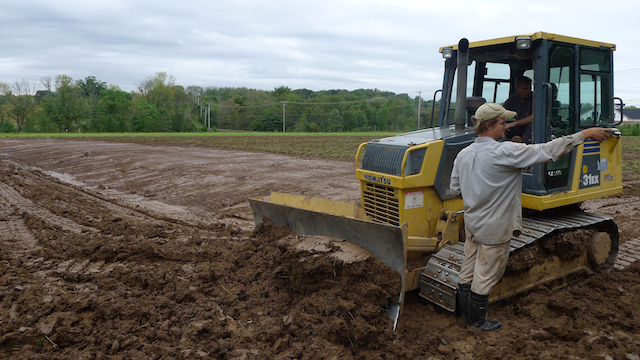
Conferring with our excavator who's putting some finishing touches on a diversion after installing a thousand feet of waterway in a troublesome field on a misty, soggy Sunday afternoon.
A new astronomical season, a new week, another flash flood, incoming additional rainfall and a lack of sunshine. So comes it, so goes it. One of these days, weeks, seasons the weather I'm sure will be more agreeable to growing organic crops. For now all we can do is our best work physically while mentally working through these challenges and occasionally accepting defeat and understanding factors that are currently beyond our control. The only way I can think of to temper the floods is by increasing the number of tunnels we have on the farm so we can grow more crops inside. Other than that, we're already underway working on water management by creating swales and berms to funnel the water away from susceptible areas to where we want it to go. Nothing solves the entire problem but all options for weathering the weather need to be addressed. The only thing worse that overly wet weather is cold wet weather and cold wet soil. And into autumn we go.
There is still much to appreciate and be thankful for and I'm trying my best to focus on whatever those things might be. This isn't the first exceptionally difficult and wet year we've endured and I'm sure it won't be our last. The best we can do is learn from it and adapt. Is it a changing climate and a harbinger of future conditions? Is it a cyclical anomaly? All the above, none of the above, whatever, we'll try to figure it out. Like I said some other time before, in 30 years we'll be perfect farmers and this will be a perfect farm. Just in time for someone else to take the reins (or the rains).
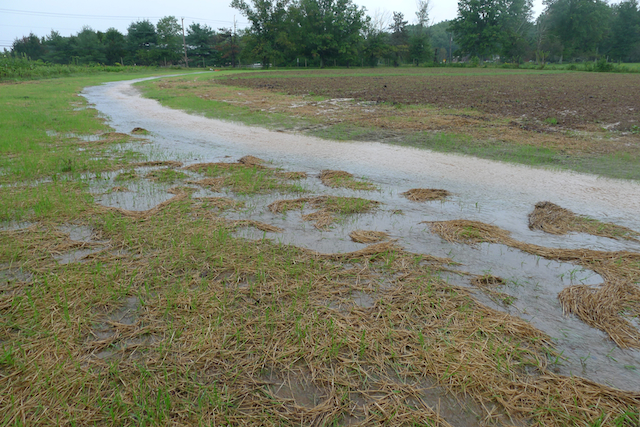
Completed waterway in Field 2 was up to the challenge of 3" of rain and another flash flood.

September 16, 2018
Spinach as a Benchmark
by Farmer Derek
Spinach as a Benchmark
by Farmer Derek
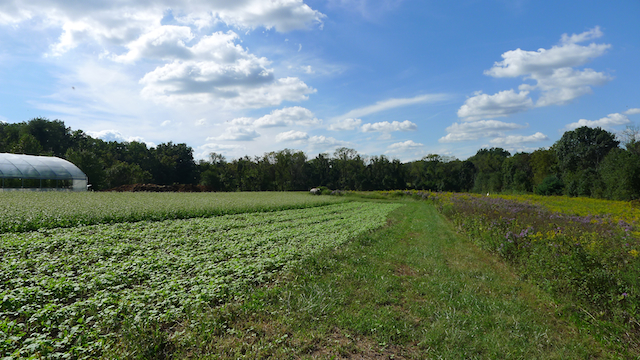
A welcomed Sunday sun scene. Two batches of a summer sown cover crop mix of buckwheat, oats, crimson clover, and daikon radish on the left and our perennial pollinator habitat on the right.
Some very good sunshine today thankfully exceptionally give us more please! Exuberant joy!
And a week ago we were on the heels of a heat wave, tired of the sun, and needing a bit of rain. A tale of two contrasts is the story of the season, or a tale of extreme weather, or just a tale of having to think too much about the weather and plan the workload each week in minute detail to get dry-ground-required jobs finished just prior to the next wet weather event. Okay so it could have definitely have been worse. Overall harvests have remained ample but because the whole season has been on the wet side our standard has probably changed. Just the other day I had a brief glimpse into a forgotten mindset from past seasons when moderate and adequate and evenly spaced rainfall allowed every single crop to reach its full potential graciously, gloriously. Now I realize that that is probably not an accurate memory but perhaps a wish.
Realistically there are conditions that crops on our farm thrive the most in. Probably excess rainfall has the most deleterious effect on crops. Most of our bare ground fields would be happiest with a 1/4" of rain a week. It was such a wonderful experience a few weeks ago when the ground began to dry out; the crops seemed to shine (I was probably projecting). Of course after the 2.5 weeks of dry weather with two heat waves intermingled they did get thirsty and asked for irrigation (we complied). But there really were times other seasons where the tops of the beds would dry out, surfaces of plants would dry out to help minimize disease, and in the organic matter rich healthy soil below there would be enough moisture to keep plants thriving on our ubiquitous north facing slopes. Those were the days.
Spinach, the most sensitive crop we grow and a benchmark of the weather, has had a tough time of it this season. Ten years ago we tried direct seeding spinach on the farm. It's not as fast and reliable as a brassica green like arugula so we switched to transplanting it a couple of years later in the spring. We harvested a good amount for a week or so that spring way back in 2013 I think. Two or three of the plantings then got upset about moisture and were unharvestable. We thought "why waste time, space, resources on a crop that is so difficult to grow?" So we took a break for a couple of years while enjoying some good weather seasons and then decided to give it a go again. For the past 3 years have been transplanting it and mostly have had more harvest success. This spring was the first time in a long while where 2 of the 3 plantings got sick and weren't harvestable. For our fall sowings we germinate in our artificially cooled crop storage room (55-60 degrees) then transplant out after 4-5 weeks of growing on in our hoop house. The last seven days of rain/mist/moist weather spinach does not like. Perhaps it will pull through for an October/November harvest. Today's sunshine has me hopeful. We have one more planting to make outside, then 3-4 plantings inside our tunnels where plants seem to do much better because of the climate and moisture control.

September 16, 2018
Preserving the Harvest
By Linda Dansbury
Preserving the Harvest
By Linda Dansbury
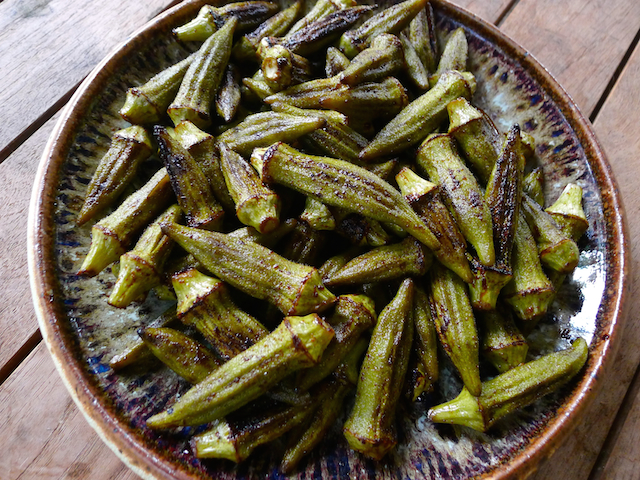
Dana and Derek's current favorite food: oven roasted okra!
This time of year, I find myself in the kitchen for longer periods to get the harvest cooked and put away for use later in the year. Usually, the weather is much cooler and less humid, but I guess the shorter day length is still driving me to do my "work". Below are a few of the things I made this past week. If you have anything you want to share with fellow members, please send to me at lindadansbury@comcast.net
Eggplant, peppers, onions, garlic, tomatoes - made a nice batch of Caponata (1 2). We have 2 recipes on this site. I kind of do a blended version. The one recipe says to roast whole eggplants; the other says to cut them up before roasting - which is the route I take because it saves time. I ate some for dinner that night and froze the rest. The recipe recommends using it as a topping for bruschetta and to eat it at room temperature, but I typically cook up some sausage and sometimes a whole grain pasta and use it as a sauce - yum!!
Okra, tomatoes, onions, peppers, hot pepper - made the Okra with Tomatoes and Corn, again, eating some as I made it and freezing some for later enjoyment.
Tomatoes, peppers, onions, hot pepper - made Salsa using a recipe from my Ball canning book. There is also a recipe on this site I forgot about - Oven Roasted Tomato Salsa - I think I will make it this week, but will probably add some sweet peppers as well.
Spaghetti squash - topped cooked spaghetti squash with one of the Uncooked Tomato Sauce recipes from this site. Delicious!
Peppers - these are so sweet I have been cutting them up and eating as a snack - yum!

September 16, 2018
Summer's Final Harvest
by Farmer Dana
Summer's Final Harvest
by Farmer Dana
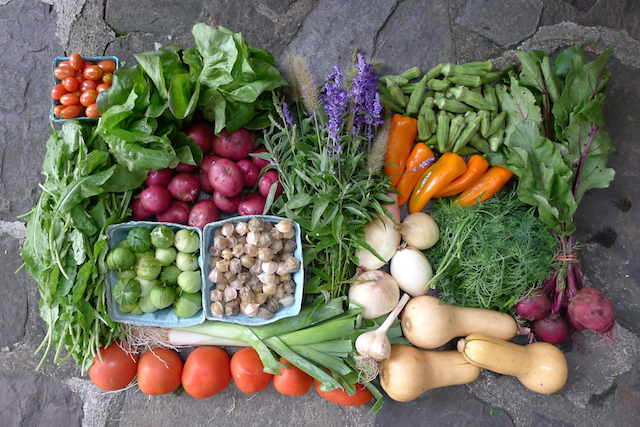
Main Season Harvest #18 (Week B) should include butternut winter squash, potatoes, beets with greens, garlic, leeks, fresh sweet onions, lettuce, tomatoes, sweet peppers, okra, hot peppers, eggplant, carrots, arugula, greens mix, Swiss chard, kale, Italian dandelion greens, dill, and cilantro. Some items will be a choice. U-pick should include cherry/grape tomatoes, tomatillos, husk cherries, herbs, and flowers.

September 16, 2018
Workshifts this Week (9/17-9/23)
By Derek McGeehan
Workshifts this Week (9/17-9/23)
By Derek McGeehan
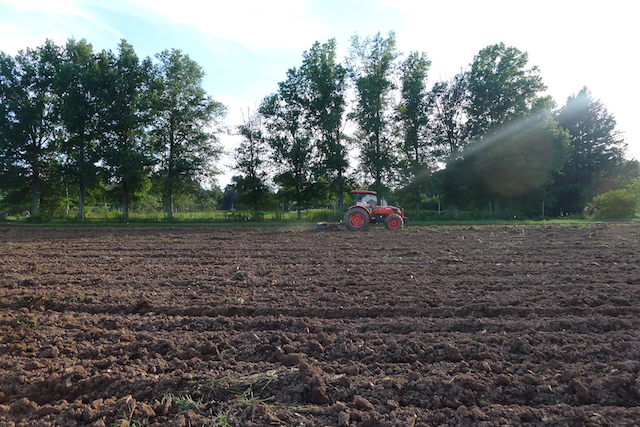
Using the disc harrow to incorporate a cover crop mix of oats, crimson clover, and forage peas on an unusually sunny Sunday.
Workshifts scheduled for this week:
- Wednesday (9/19) 10:00am-12:00noon
- Friday (9/21) 10:00am-12:00noon
- Sunday (9/23) 9-11am
Workshift sign-up instructions may be found here.
We're quickly approaching the end of farm work opportunities so please consider signing up soon for a workshift if you chose the work discount option for your share. If you chose the discount but don't think you'll be able to fulfill the work obligation simply send us a check to cover the hours/balance (4 hours for a half share, $60; 6 hours for a medium share, $90; 8 hours for a full share, $120; or $15/hour if you worked partial).
Thank you!

September 16, 2018
Transitioning to Fall
By Linda Dansbury
Transitioning to Fall
By Linda Dansbury
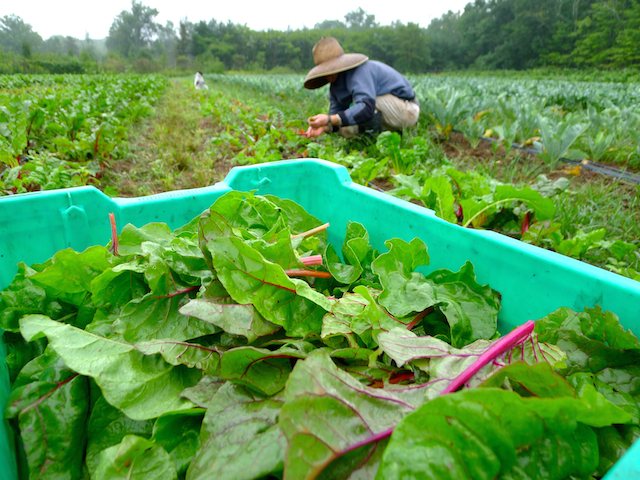
Swiss chard harvested on a misty morning last week.
Parts of the pick up room look like it is fall and parts still look like summer. I welcome the greens back and love to make veggie saute's, combining the last of the summer veggies along with fall's harvest. I participated in a seasonal cooking demo at the Farmer's Market yesterday and we did a combination of local mushrooms, roasted beets, sauteed peppers, kale and Swiss chard - the only seasoning was sea salt and pepper. Food is always appreciated at the Market, but everyone, even a couple that said they are not big veggie eaters, loved it.
I love it when the beets are fresh from the field with their tops on - remember to use the greens - they are nutritious and delicious - if we had the beet greens from the above beets, they would have been added. The greens don't last for as long as the beets in the fridge, so cut them off and store separately.
Since the Swiss chard and other greens are back, remember that Swiss chard is a great alternative to spinach in a lot of dishes. The crop right now is also so mild that I have been adding a few of the smaller leaves to my salads. A lot of people don't like dandelion greens, but I have found if you add them to a veggie stew that includes sweet vegetables such as peppers and beets, it really tames the bitterness of dandelion and other bitter greens. Dandelion is so healthy for you, so it is good to find a way to use it.
The onions and leeks are bountiful - if you don't use your onion share up each week, make sure to check them regularly and use the ones that are starting to get soft first so you don't end up having to throw any of them away.
Enjoy the harvest!

September 9, 2018
Seasonal Metamorphosis
by Farmer Dana
Seasonal Metamorphosis
by Farmer Dana
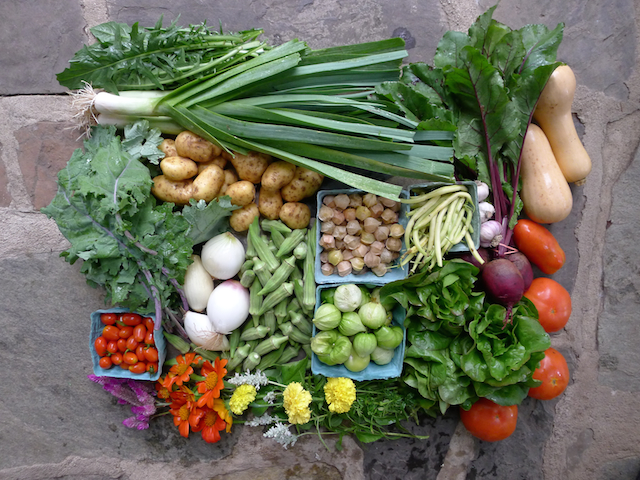
Main Season Share #17 (Week A) should include butternut squash, potatoes, garlic, onions, leeks, beets with greens, tomatoes, rosemary, kale, Swiss chard, Italian dandelion, lettuce, sweet peppers, hot peppers, okra, and eggplant. Some items will be a choice. U-pick should include yellow snap beans, cherry/grape tomatoes, husk cherries, tomatillos, herbs, and flowers.

September 9, 2018
Workshifts this Week (9/10-9/16)
by Farmer Derek
Workshifts this Week (9/10-9/16)
by Farmer Derek
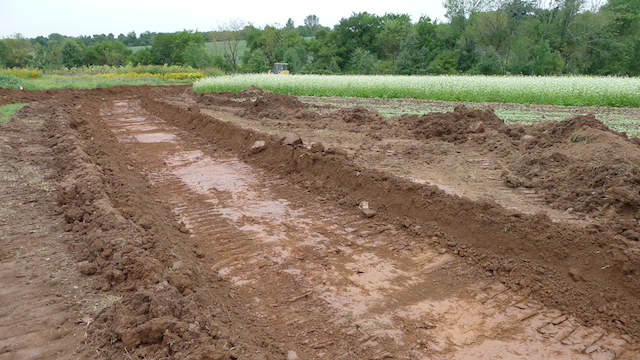
Grassed waterway construction commencing in Field 3. The earthmoving work won't involve workshifts but maybe you'll help us with some mulching.
Workshifts scheduled for this week:
- Wednesday (9/12) 9-11am
- Friday (9/14) 10:00am-12:00noon
- Sunday (9/16) 10:00am-12:00noon
Workshift sign-up instructions may be found here.
We're quickly approaching the end of farm work opportunities so please consider signing up soon for a workshift if you chose the work discount option for your share. If you chose the discount but don't think you'll be able to fulfill the work obligation simply send us a check to cover the hours/balance (4 hours for a half share, $60; 6 hours for a medium share, $90; 8 hours for a full share, $120; or $15/hour if you worked partial).
Thank you!

September 9, 2018
Can We Ignore The Weather?
by Farmer Derek
Can We Ignore The Weather?
by Farmer Derek
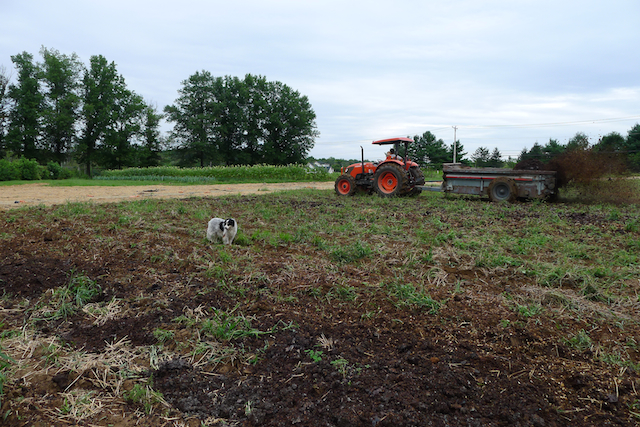
Spreading compost on a fallow field.
Last week on the farm...
The stifling heat and super dry conditions forced us to set up and irrigate all of the crops except for sweet potatoes which seem to be unbothered by anything. All the crops received two doses of water to give us the satisfaction that at least we used the drip tape enough to make the extra work worthwhile. The crops definitely needed a serious drink amid soaring temperatures after missed rainfall last weekend and perked right up after 6-8 total hours of trickle irrigation. That was the driest the farm has been all season.
The NRCS/USDA water management project commenced last week as well. A project 3 years in the making, it's great that it is finally beginning. Grassed waterways will be created in the most problematic areas to collect runoff, minimize erosion, and send the water hopefully where we want it to go. Significant quantities of soil need to be moved around. The waterways are 20-30' wide, 6-12" deep, and over a 1000' long. After the bulldozer does its job we sow appropriate seeds, roll out erosion control blankets, and add straw to hold moisture and protect the seeds. Two out of 4 areas have been completed.
Additional crops were transplanted and direct seeded including arugula, greens mix, hakurei turnips, scarlet queen turnips, broccoli raab, lettuce mix, mini lettuce, spinach, chard, curly kale, collards, and russian kale. Beds were reshaped to kill any germinating weeds prior to planting.
Compost was spread over a 1.5 acre fallow field. Half a day was spent trying to fix the ancient compost spreader that broke 3 or 4 times and prevented me from having time to sow an oat and clover cover crop prior to Friday night's rain and forced me to finish the task by working all day Saturday.
Crop maintenance was a big part of the workload last week including weeding in row and mowing walking aisles.
Half days were given to the crew on the hottest days.
Since we can't ignore the weather on the farm we'll endure what we're given this week and adapt to the conditions. Will this week be bookended by moisture from two tropical storms? Yippee.
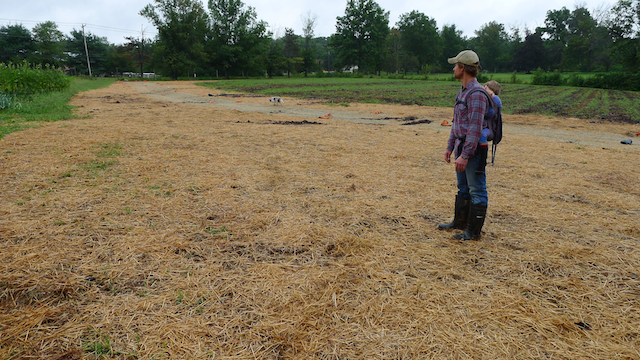
Field 2 waterway completed.

September 9, 2018
Love the Okra!
By Linda Dansbury
Love the Okra!
By Linda Dansbury
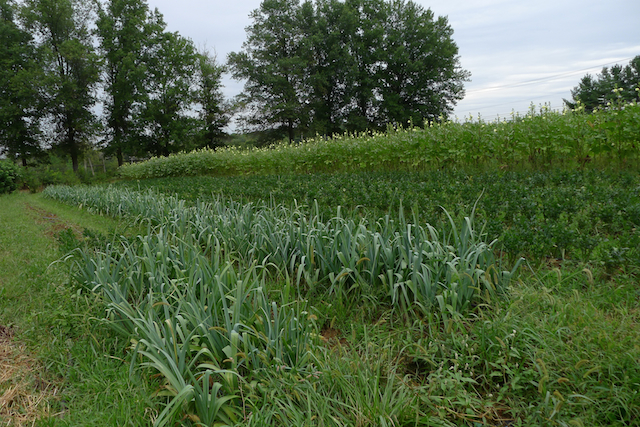
With subtle yellow flowers at their crown, Okra plants tower over leeks and celeriac. Okra has enjoyed this late summer heat and has upped its production 50-75%.
Okra!
If you haven't tried it yet (it has been a choice for the past several weeks and I for one have taken it most weeks), please do so. It is a versatile veggie - I have prepared it stewed and in a light shrimp gumbo, but our favorite, and possibly the easiest is roasted or grilled.
Grilled okra, simply heat the grill and place the pods on the grates for 2-4 minutes, turning midway through. If the pods are small, a grill pan keeps the pods from falling between the grates. When nicely charred, remove from grill and add a little salt and pepper and if desired, a squeeze of lemon. Websites often talk about a dipping sauce, but I don't really think they need it.
Thank you fellow member Carol Barry Marini for sending me the following on okra:
"As a displaced southerner, I've been thrilled to find okra in the pick-up room the past few weeks. I grew up eating it, but it's not as readily available up here...so, the past few weeks have conjured up many happy food memories for me!
I thought I'd send along a few of my favorite ways to cook it, in case you think other members might enjoy. Recipes/methods are below.
Roasted okra - As simple as it sounds. Trim the stem end off the pod, and split large pods lengthwise (if they're smaller than, say, your pinky you can leave them whole). Toss with olive oil, salt, and pepper. Roast at 425-450 for 15-20 minutes, shaking the pan at least once, until golden brown.
Fried okra - A little messy to make, but a special treat. Slice pods into small rounds (1/2 inch or so). Heat 1/4 to 1/2 inch of neutral flavored oil in a large skillet to ~375. Working in batches, dip okra into buttermilk, then into a mix of flour and cornmeal (I don't usually measure, but I think about 2 parts flour to 1 part cornmeal is about right). Fry until golden brown, remove from the oil and drain on paper towels, seasoning with salt when they come out of the oil.
Stewed with tomatoes - I loved this as a kid. We'd have it as a side, or with chicken added as a main, served over rice in both cases. The recipe for okra and corn with tomatoes on the Anchor Run website is basically the method, but I think what we used to have was simpler...onion, maybe some garlic, sauteed in oil or bacon drippings, okra and tomatoes added and simmered for 15-20 minutes (longer if you find okra too slimy), and then seasoned with salt & pepper.

September 9, 2018
Enjoying the variety
By Linda Dansbury
Enjoying the variety
By Linda Dansbury
I was away for several days, so took some time off from cooking. I was glad to get back into the kitchen to enjoy my veggies. Please send me how you enjoyed your harvest at lindadansbury@comcast.net and please put Anchor Run in the subject line.
Hot pepper, onion and herbs - made ceviche with fresh halibut using a bit of hot pepper and onion from farm. Yum!!
Peppers, parsley, garlic - made Romesco Sauce using the beautiful red and orange peppers - I made it last year too, froze it and enjoyed it all year with fish, chicken, pork and veggies.
Tomatoes, green beans, onion, garlic - made a very simple roasted dish with halibut. Cut tomatoes into bite sized pieces (or use cherry tomatoes), thinly slice an onion, clean beans, but leave whole. Make a sauce by combining olive oil, minced garlic, dried oregano and coriander, salt and pepper, lemon zest and lemon juice. Dip the veggies in the sauce, remove them and place on baking sheet in a single layer. Cut the fish into 1-1/2" strips and dip into the sauce, drain and place on baking sheet, separate from the veggies. Roast in a 450 degree oven. The recipe I used said 15 minutes. The veggies were perfect after 15 minutes, but I took the fish out at 9 minutes and it was great.

September 9, 2018
Beautiful Peppers!
By Linda Dansbury
Beautiful Peppers!
By Linda Dansbury
Late summer into fall the peppers are so prolific and delicious. But...you may be wondering how to use them all up.
Roasting, either in a hot oven or on the grill is a great starting point to so many end uses:
Roasted peppers - grill or roast in hot oven until the skins are nicely darkened on all sides. Place in paper bag until cool, remove skin and seeds and then slice into strips. Place in bowl, add thinly sliced garlic, a nice drizzle of olive oil, a dash of balsamic vinegar and a bit of salt and pepper - this is so delicious. Love it on grilled bread or added to sandwiches.
Pepper Puree - a few years ago, fellow member Carolyn Lyday sent me the method as well as variations for using it. Click on the link to see all the ways she varies it and uses it.
Romesco Sauce - I made this last year - it is similar to the Pepper Puree above. As with above, it freezes well for use throughout the year over fish, chicken, pork and veggies. This is a classic Spanish use of roasted peppers.

September 2, 2018
Sweet Sixteen
by Farmer Derek
Sweet Sixteen
by Farmer Derek
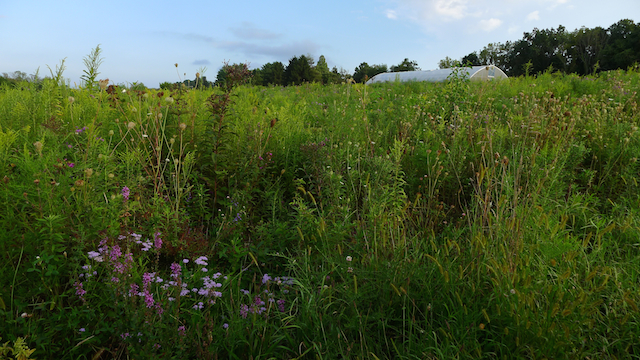
No time for a harvest photo today thanks to an absence of rain but at least the pollinator habitat is looking good. Share will be pretty similar to #15 shown below.
Harvest #16 (Week B) should include spaghetti squash, potatoes, onions, scallions, garlic, rosemary, lettuce, chard, kale, dandelion greens, tomatoes, sweet peppers, hot peppers, eggplant, and herbs. U-pick should include yellow snap beans, cherry and grape tomatoes, tomatillos, husk cherries, flowers, and herbs.
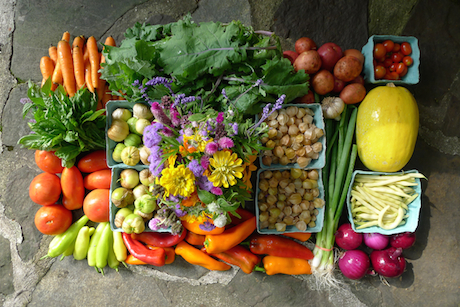

September 2, 2018
Upcoming Potluck
by Farmer Dana
Upcoming Potluck
by Farmer Dana
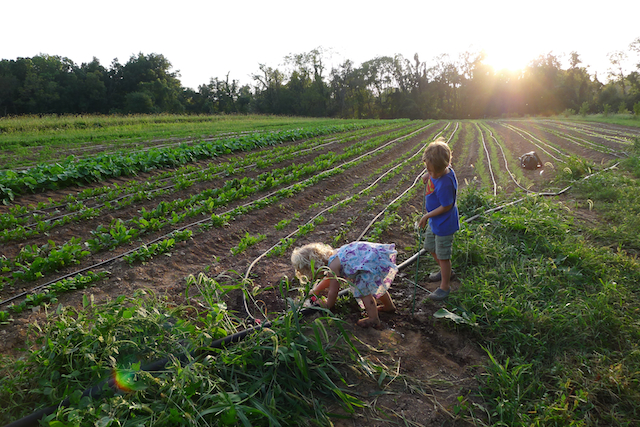
Mischievous kids automatically attracted to water and mud and long pointy sticks.
Join us for a meal under the pavilion 5:30-9pm Saturday September 8th. Bring a dish to share that serves 6 adults, your own place settings, and a beverage of your choosing. There may be a fire for s'mores as well as live acoustic music (if folks are kind enough to bring their instruments and play for all of us again!).

September 2, 2018
Workshifts this Week (9/3-9/9)
by Farmer Dana
Workshifts this Week (9/3-9/9)
by Farmer Dana
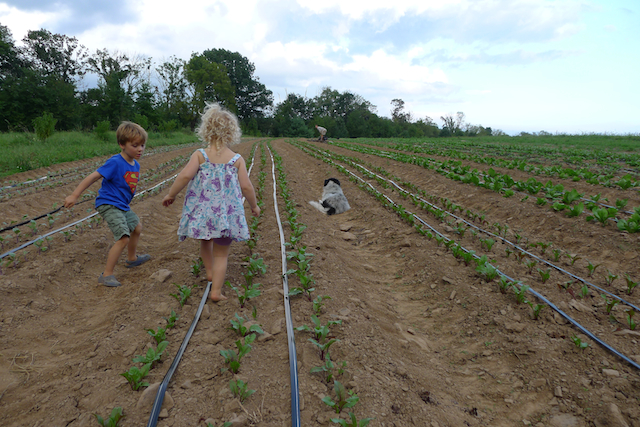
Coaxed the family to join in setting up the irrigation system towards the end of a long Sunday.
Workshifts scheduled for this week:
- Tuesday (9/4) 9-11am
- Wednesday (9/5) 9-11am
- Friday (9/7) 9:30-11:30am
- Sunday (9/9) 8-10am
Workshift sign-up instructions may be found here.
Workshifts typically meet under the large red maple just outside of the pick up room. Please wear appropriate clothes and footwear for working outside and bring your own gloves and water.
Thank you!

September 2, 2018
Sometimes It's Hard
by Farmer Derek
Sometimes It's Hard
by Farmer Derek
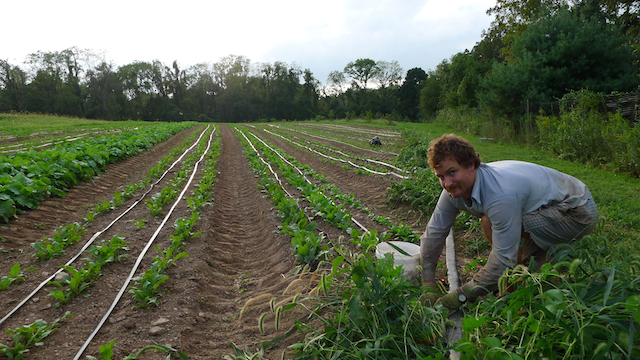
Somewhat reluctantly spent a good portion of Sunday installing irrigation infrastructure after all of the forecast rain missed us.
Well, I was definitely counting on and anticipating a healthy dose of rainfall this past Friday. Ninety percent chance of up to an inch had me convinced it was coming. Alas, it amounted to nothing and now I must contemplate setting up irrigation systems across the farm or await the next incoming round of wet weather. Perhaps we'll get lucky Sunday when there's another slight chance of rain; otherwise it looks like we'll have to wait until next weekend. It does feel strange to be discussing water and rain this way, wanting it, when for much of this season it's been the opposite. That probably adds some frustration (obviously). Sometimes it's nice to give oneself over to the controls of the weather. When it rains we're cared for and it removes some need for decision making because obviously in our climate we receive fairly regular rainfall as opposed to parts of the dry west where they simply know it won't rain so why not just always have irrigation at hand and set up. Thus we either wait for and depend on rainfall or we adjust and run the drip tape and set up the headers and/or set up the sprinklers. Please give us the appropriate amount of rain for once this season.
Last week we endured quite a heat wave for this time of year, especially on the heals of very cool and mild weather last weekend. The fields dried out so we were able to cultivate where needed, including with hand tools and with the tractor, as well as harvest the last of the potatoes and all of the butternut squash. We transplanted more fall crops including napa/chinese cabbage, kohlrabi, lettuce, radicchio, endive, escarole, dill, cilantro, and parsley. We cleaned up fields and sowed additional cover crops and also spread some compost on resting fields. It was a productive week.

POSTS BY TYPE
POSTS BY MONTH

